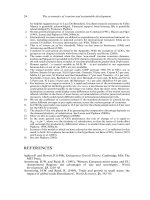THE ECONOMICS OF MONEY,BANKING, AND FINANCIAL MARKETS 358
Bạn đang xem bản rút gọn của tài liệu. Xem và tải ngay bản đầy đủ của tài liệu tại đây (43.48 KB, 1 trang )
326
PA R T I V
The Management of Financial Institutions
banks were not well developed, banks rarely borrowed from other banks to meet
their reserve needs.
Starting in the 1960s, however, large banks (called money centre banks)
began to explore ways in which the liabilities on their balance sheets could provide them with reserves and liquidity. This led to an expansion of overnight loan
markets, such as the federal funds market in the United States and the overnight
funds market in Canada, and the development of new financial instruments such
as negotiable CDs (first developed in 1961), which enabled money centre banks
to acquire funds quickly.2
This new flexibility in liability management meant that banks could take a different approach to bank management. They no longer needed to depend on
chequable deposits as the primary source of bank funds and as a result no longer
treated their sources of funds (liabilities) as given. Instead, they aggressively set
target goals for their asset growth and tried to acquire funds (by issuing liabilities)
as they were needed.
For example, today, when a money centre bank finds an attractive loan opportunity, it can acquire funds by selling a negotiable CD. Or if it has a reserve shortfall, funds can be borrowed from another bank in the overnight market without
incurring high transaction costs. The overnight market can also be used to finance
loans. Because of the increased importance of liability management, most banks now
manage both sides of the balance sheet together in an asset liability management
(ALM) committee.
The emphasis on liability management explains some of the important changes
over the past three decades in the composition of banks balance sheets. While
negotiable CDs and bank borrowings have greatly increased in importance as a source
of bank funds in recent years, chequable deposits have decreased in importance.
Newfound flexibility in liability management and the search for higher profits have
also stimulated banks to increase the proportion of their assets held in loans,
which earn higher income.
Capital
Adequacy
Management
Banks have to make decisions about the amount of capital they need to hold for
three reasons. First, bank capital helps prevent bank failure, a situation in which
the bank cannot satisfy its obligations to pay its depositors and other creditors and
so goes out of business. Second, the amount of capital affects returns for the owners (equity holders) of the bank. Third, a minimum amount of bank capital (bank
capital requirements) is required by regulatory authorities.
Let s consider two banks
with identical balance sheets, except that the High Capital Bank has a ratio of capital to assets of 10% while the Low Capital Bank has a ratio of 4%.
HOW BANK CAPITAL HELPS PREVENT BANK FAILURE
High Capital Bank
Assets
Low Capital Bank
Liabilities
Reserves $10 million
Loans
$90 million
2
Deposits
Bank
capital
$90 million
$10 million
Assets
Reserves $10 million
Loans
$90 million
Liabilities
Deposits
Bank
capital
$96 million
$ 4 million
Because small banks are not as well known as money centre banks and so might be a higher credit
risk, they find it harder to raise funds in the negotiable CD market. Hence, they do not engage nearly
as actively in liability management.









